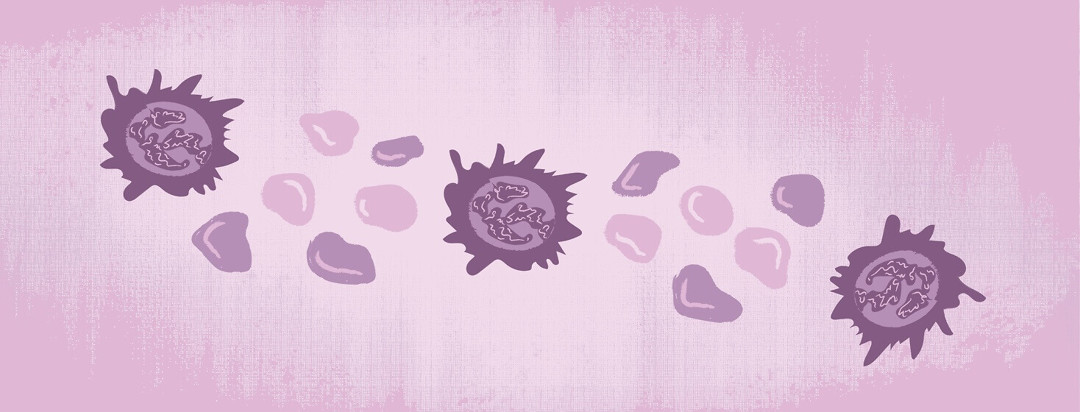Understanding Hairy Cell Leukemia
What is hairy cell leukemia?
Hairy cell leukemia is a rare form of blood cancer, accounting for only 2% of leukemia cases.1 The name, hairy cell leukemia, comes from the appearance of the cells under the microscope. Hairy cell leukemia is a type of chronic lymphocytic leukemia (CLL). As a chronic blood cancer, it develops over a long period of time and is generally a slower growing form of leukemia.
How does hairy cell leukemia develop?
Within bone marrow, stem cells (immature cells) can become red blood cells, white blood cells, and platelets. Red blood cells deliver oxygen throughout our body, and platelets are essential for blood clotting. White blood cells are the core of our immune system and are comprised of three main types of cells: B cells, T cells, and natural killer cells. Our B cells produce antibodies that protect us and T cells provide our surveillance system. If a cancer cell or virally infected cell is found, the natural killer cells will attack and eliminate that cell.
Hairy cell leukemia develops from abnormal B cells, which are not able to carry out their normal functions. In addition, these cells crowd out other developing blood cells in our bone marrow and this can lead to frequent infections, easy bleeding, and anemia.2
Who gets hairy cell leukemia and what are the risk factors?
While the cause of hairy cell leukemia is unknown, older age and male gender are the only known risk factors. Men are four to five times as likely to develop hairy cell leukemia than women, and it is rarely found in people under the age of 30.1,3
What are the symptoms of hairy cell leukemia?
The symptoms of hairy cell leukemia resemble that of other types of leukemia. Common symptoms include: infections, weakness or feeling tired, and pain in the abdomen.2,3 Other symptoms include bleeding or bruising easily and feeling breathless. Weight loss can also occur, which can be associated with an enlarged spleen. A fraction of hairy cell leukemia patients have no symptoms.
Are mutations associated with hairy cell leukemia?
A genetic mutation called BRAF V600E is associated with most cases of hairy cell leukemia. Since this mutation is only rarely seen in other B cell diseases, it is considered a molecular hallmark of hairy cell leukemia.1
What are the stages of hairy cell leukemia?
Unlike other cancers, there is not a staging system for hairy cell leukemia. Instead, doctors analyze blood to look for any deficiencies in red blood cells, white blood cells, or platelets. They also feel for signs of swollen lymph nodes or an enlarged spleen. Physicians also look for the genetic mutation associated with the disease.3
How is hairy cell leukemia treated?
In patients who have no symptoms, a watch and wait approach is used. Treatment is not needed until symptoms develop. The most common first line treatment for hairy cell leukemia is chemotherapy. When being treated with one of two chemotherapy agents, patients are monitored for developing secondary cancers.
Hairy cell leukemia commonly comes back after a period of remission. After 5 years, it comes back in 24-33% of patients. After 10 years, it comes back in 42-48% of patients.3 If hairy cell leukemia comes back, chemotherapy may be used again, or one of two immunotherapies may be used. Immunotherapies increase the body’s natural abilities to fight cancer. Some relapse patients are treated with both chemotherapy and immunotherapy.
In some hairy cell leukemia cases, the spleen is removed in a procedure called splenectomy. Since this treatment does not alter bone marrow production of abnormal B cells, and patients have a recurrence of disease in only 12-18 months, splenectomy is less often used, as more effective treatment options are now available.2
Currently, in clinical trials, researchers are addressing BRAF pathway inhibitors and immunotoxins. An immunotoxin is an antibody fused to a toxin molecule, where the antibody specifically binds the hairy cells. The toxin molecule then functions to selectively kill the hairy cell. While BRAF pathway inhibitors show promise, currently available compounds are associated with adverse events in patient trials.1
What is a common prognosis?
A patient’s prognosis for hairy cell leukemia is dependent on how fast the cancer develops and how well they respond to treatment. A better prognosis is correlated to slow cancer development and a strong response to treatment. In many cases, treatment results in a long remission.2 Physicians often expect a normal life expectancy in patients with hairy cell leukemia. A 2017 study found a greater than 85% survival rate in patients with hairy cell leukemia.4
What differentiates hairy cell leukemia from HCL-V?
There is a disease called HCL-V (hairy cell leukemia - variant) that is similar in some ways to hairy cell leukemia but is, in fact, a distinct disease. Patients with HCL-V have the same hairy B cells that hairy cell leukemia patients have, and they also have too many of these abnormal B cells. It’s important to distinguish between hairy cell leukemia and HCL-V because they are genetically distinct diseases that respond differently to treatment, despite having a similar appearance under the microscope. While an examination of how the B cells appear is not sufficient to distinguish between the two diseases, a positive genetic test for the BRAF mutation can distinguish between these two diseases, as patients with HCL-V do not have the BRAF mutation.1

Join the conversation